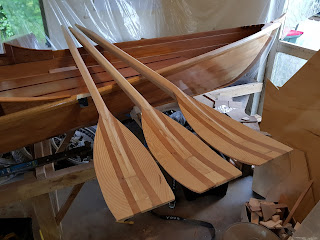Building the boat with company is fun: an unbroken stream of rowing chat, bad puns, philosophical discourse that would put Pete and Dud to shame and repetition of formulaic jokes turns the tedious tasks like sanding and gluing into a social event. There are also genuinely challenging problems to solve and techniques to learn that make it really interesting and rewarding.
The last few weeks, working on my own, have been rather dull, to be honest, though I have made progress and Harry and Kim have been there ready to hold things when needed. Unfortunately for you, gentle reader, this dullness is coming out in the rather mundane style of the recent blogs. Either that, or Joe simply has a better way with words. As long as he comes back with the leathers for the oars, I am prepared to say I am looking forward to his return.
Here's what accounted for a fair chunk of my time in the last week:
This is the rudder that we made from ply a few years back. The idea was deliberately to show the ply as a key building material and, by exposing the layers as the rudder tapers to the tip, the striations gave it a special look.
As confessed earlier, I wasted hours of work by hastily attaching the fittings in what turned out to be the wrong position, spoiling the beautiful finish in the process. I am not at all happy about messing this up: I made a mistake that might have been recoverable, but my attempts to remedy it only compounded the problem. Having swallowed the spider, bird, cat, dog, goat, cow and most of the horse, I gave up and decided to make an entirely new rudder from scratch.
I started another ply version, as I mentioned earlier, but felt that it just wasn't going to work out too well.
 |
| Ply sandwich |
 |
| Marked up |
So now, when Joe gets back from his in depth research into the yachting scene in Croatia, or cruising in Brighton, he can choose between two versions:
 |
| Mahogany and Fijian Kauri |
 |
| Ply version, before sanding |
The Kauri will be relatively light coloured, but, with varnish, darker than the above. The new ply is much lighter - almost a cream colour -, but will also darken with varnish applied. I may experiment with some staining, too. It remains to be seen whether the grain and knots that are showing will enhance or spoil the look. So far, even poor quality ply has yielded a very pleasing finish.
On the other hand, the Kauri does look good and I have invested quite a bit of effort in it, having added all that mahogany....
 The final stages for the boat: everything is varnished and I have finally fixed the seats in place.
The final stages for the boat: everything is varnished and I have finally fixed the seats in place.




















































